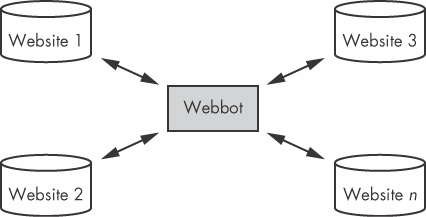All of the webbots discussed so far are small in scale, meaning they can be implemented with a single agent running on a single computer. However, as the scope of your projects grows, it is often necessary to develop webbots that scale to the size of the project. Proper scaling involves adding capacity to your webbot while not doing anything that could compromise your webbot’s ability to achieve its task.
Capacity, in this sense, may refer to either the ability to do more in less time or the ability to do the same amount of work, replicated many times, over a long period.
The question that quickly arises while scaling webbots is “How do you add capacity to a webbot without also requiring more capacity from the target website’s servers?” There is no one single way to approach scaling webbots because it is highly dependent on the webbot environment. Webbot environments can be categorized into four distinct scenarios:
One-to-many
One-to-one
Many-to-many
Many-to-one
Ultimately, the way you scale your webbot project depends on your environment. After discussing these four common webbot environments, we’ll discuss other issues related to scaling, including some ways to create multiple instances of your webbot, and finally some ideas for controlling your creations.
The webbot projects that are easiest to scale are those with a one-to-many environment, as shown in Figure 25-1.
In these projects, a single webbot gathers information from a variety of web services. In reality, the webbot may download several files from the target website, but the general environment is one where a webbot gathers a limited amount of information from a single website and then moves on to the next target, where it applies a similar approach. An example of a one-to-many environment is that used by search engines, where many websites are targeted.
These applications are the easiest to scale because they simply require the developer to apply more resources to the webbot, without serious consideration of the amount of resources that any one target website consumes. As a developer, you apply more resources by optimizing the webbot to run faster or by applying parallel webbots, as explained in Many-to-Many Environment and Many-to-One Environment.
